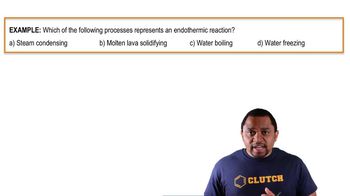Here are the essential concepts you must grasp in order to answer the question correctly.
Dissolution and Heat Transfer
When CaCl2 dissolves in water, it dissociates into calcium and chloride ions, a process that releases energy in the form of heat, leading to an increase in temperature. This exothermic reaction occurs because the energy released from forming ion-dipole interactions with water molecules is greater than the energy required to break the ionic bonds in solid CaCl2.
Recommended video:
Endothermic Processes
In contrast, when CaCl2 is added to ice at 0 °C, the dissolution process absorbs heat from the surroundings, resulting in a temperature drop. This endothermic reaction occurs because the energy required to break the ionic bonds in solid CaCl2 and to disrupt the hydrogen bonding in ice exceeds the energy released from the formation of ion-dipole interactions with water molecules.
Recommended video:
Endothermic & Exothermic Reactions Example 1
Phase Changes and Temperature Effects
The temperature of a substance is influenced by its phase. Ice, being a solid, requires energy to transition to liquid water. When CaCl2 is added to ice, it not only dissolves but also absorbs heat from the ice, which hinders the melting process and results in a decrease in temperature. This interplay between dissolution and phase change is crucial in understanding the thermal effects observed.
Recommended video:




